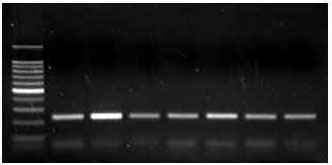| 2003 |

|
YEAR BOOK |
University College Dublin, St Vincent's University Hospital & Department of Agriculture
|
Searching genomes for new antimicrobials:
an immunogenomics approach
|

Using software designed in the South African National Bioinformatics Institute (SANBI) and The Institute for Genomic Research (TIGR), we have been assembling this large dataset into a smaller sample of better quality clusters of overlapping ESTs. We have searched this database with a variety of sensitive algorithms to find both novel antimicrobial peptides and elements of the biochemical pathways that control their expression.
In collaboration with Dr Grace Mulcahy of the Faculty of Veterinary Medicine UCD, we have examined chicken tissue infected with a protozoan parasite for expression of these predicted genes by conventional RT-PCR analysis. This approach has resulted in the identification of several previously undocumented genes, and we are now cloning, sequencing, expressing and characterising them for further study in previously established in vitro antibacterial bioassays.
Once novel antimicrobial peptides are overexpressed, they may be processed to an active form in vitro and tested in previously established antibacterial bioassays.
An important commercial aim is to develop new treatment regimes to combat common veterinary diseases, which result in large economic losses in the poultry industry every year. This combined bioinformatic and molecular biological strategy is also reaping other dividends, as it increases our knowledge of the innate immune system in the chicken and helps to show how they control pathogenic assaults.
This work is funded by the Irish Department of Agriculture under the Food Institutional Research Measure (FIRM).
Contact: Team Leader: Professor Cliona O'Farrelly, Education and Research Centre,
St Vincent's University Hospital;
Tel: 01 2774000; Fax: 01-283-8123; E-mail: [email protected] ;
Team Members: Dr Andrew Lloyd, Dr Tharappel James, David Lynn MSc, Susan Gaines MSc & Rowan Higgs BSc.